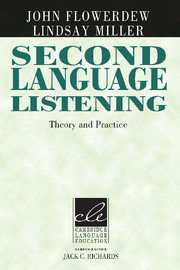Part III - KEY ISSUES IN TEACHING AND TESTING
Published online by Cambridge University Press: 04 February 2010
Summary
In Part III, we present what we consider to be three key issues that all language teachers facewhen helping learners develop listening skills. At the end of each chapter, we comment on how the pedagogical model, presented in Part II, may assist teachers in better dealing with these key issues.
In Chapter 9,we investigate howtechnology is used to facilitate listening. In most language classes today, it is common for the teacher to use some form of technology, ranging from tape recorders to computers, in the listening lessons. Access to authentic listening material, or simply to a variety of recorded listening material, allows teachers opportunities to explore dimensions of the pedagogical model that they might not have been able to do otherwise.
Chapter 10 focuses on how listening is developed through the use of good questioning techniques. Variety in the use of questions helps stimulate learners' interest and aids the teacher in checking different levels of comprehension. Therefore, developing skills in the use of appropriate questions is of paramount importance for all language teachers. In Chapter 10, we review some of the questioning techniques teachers can use. We then focus on the different dimensions of the pedagogical model and suggest that each dimension needs different types of questions in order for students to be fully involved in developing their listening skills.
- Type
- Chapter
- Information
- Second Language ListeningTheory and Practice, pp. 163 - 164Publisher: Cambridge University PressPrint publication year: 2005



